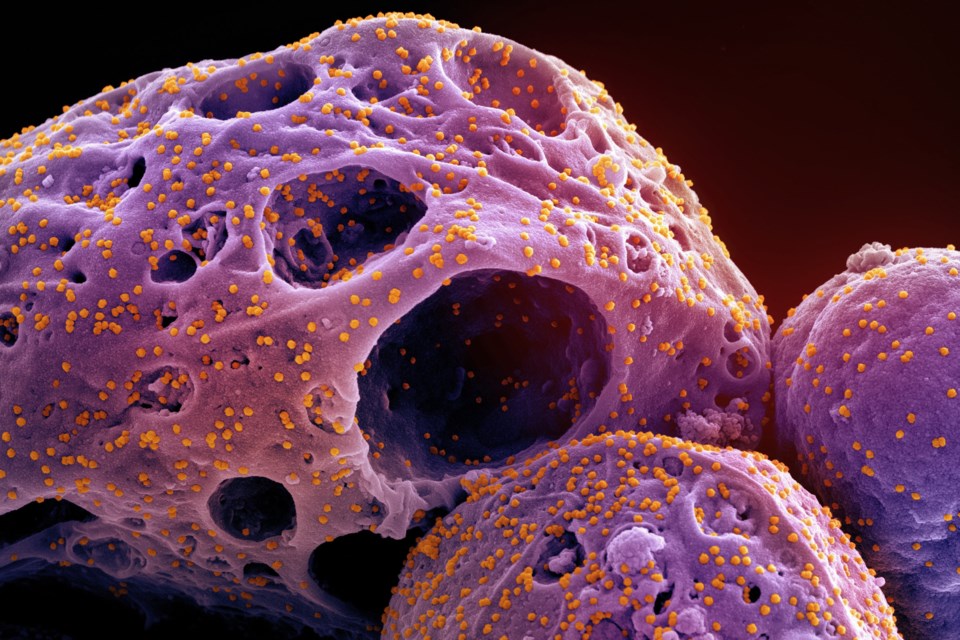As cases of the Omicron subvariant XBB.1.5 increased in some countries, a Canadian evolutionary biologist says he saw the need for a nickname to spark interest in notable lineages instead of hard-to-remember strings of letters and numbers.
Ryan Gregory of the University of Guelph dubbed the latest subvariant Kraken, the name of a Scandinavian mythological sea creature, as more people fell ill with XBB.1.5 in the northeast United States last month. The Centers for Disease Control estimates the subvariant makes up the majority of cases in that region.
The name Kraken was agreed upon by Gregory's "eclectic" online community of global "variant trackers," including those who do wastewater analysis as well as citizen scientists who sift through data to identify new mutations.
Gregory says the group adopted monikers for previous Omicron subvariants — Gryphon (XBB), a creature that is a mix of a lion and an eagle and Hippogryph (XBB.1), a combination of Gryphon and a horse. Kraken is the latest addition to the XBB family of subvariants and is a combination of two earlier subtypes.
The World Health Organization used the Greek alphabet to categorize variants of concern: Alpha (B.1.1.7), Beta (B.1.351), Gamma (P.1), Delta (B.1.617.2) and Omicron (B.1.1.529), which has spawned multiple descendent sublineages.
Gregory said the Omicron subvariant BA.2.75 seemed to get more attention after an online post dubbed it Centaurus, suggesting that a snappy name could better inform the public about the evolution of Omicron.
WHY USE MYTHICAL CREATURES?
"It's easier if they have a more recognizable name than just an alphabet soup," says Gregory, adding thatany type of categorization would work, including astronomical names.
Gregory says the current naming system is difficult to understand by the general public. It involves a group of scientists that use a software program called Pangolin to track a variant's evolutionary history. A sequence of letters starting with A are separated by a period followed by numbers indicating branches from a particular lineage.
Gregory says he wants to offer clear information about the evolutionary trees of variants and how their linages are related. "I normally work on genome evolution in animals. So you're talking about slow evolution. Viral evolution in the span of a couple of months is just light speed for someone like me."
WHAT DO OTHERS IN THE SCIENTIFIC COMMUNITY THINK?
British Columbia's provincial health officer Dr. Bonnie Henry agrees the current naming system gets complicated. But she thinks a sea monster is not the best descriptor.
"This is my dilemma. How do you walk that tightrope?"says Henry.
"Because we want people to be aware and concerned but we don't want people to be panicked. And sometimes giving these types of mythical names creates a sense of fear that, hopefully, is not warranted.
"I've heard from people who say, 'Oh, my gosh. This is going to come. I have no control over it, it's going to cause more severe illness, I'm more at risk.' People are feeling very vulnerable after what we've been through."
IS XBB.1.5 MORE CONTAGIOUS OR SEVERE?
While the WHO has said XBB.1.5 is the most transmissible subvariant so far, it has not taken off in Canada. Henry says it can bind more easily to a specific protein called ACE2 in the back of the nose and throat where the SARS -CoV-2 virus enters the body, triggering infection.
However, she says XBB.1.5 has not led to more severe illness or an increase in hospitalizations for people who are vaccinated, and because of hybrid immunity from infection.
"We have to watch and we have to continue to monitor. But right now, what we're seeing is the things that have worked for all of Omicron over the last year are still things that are going to protect us from hospitalization, severe illness and death," Henry says of measures like up-to-date vaccinations and masking in crowded indoor spaces.
"The bivalent vaccine in particular gives us good protection against infections for the first little while, but also against severe illness. I'm not worried," she says of concerns that hospitals could be overburdened by XBB.1.5.
HOW MANY DETECTIONS OF XBB.1.5 ARE IN CANADA?
Omicron and its sublineages are circulating in various provinces, but the number of XBB.1.5 infections is not known.
The Public Health Agency of Canada said Monday that 42 detections of the subvariant had been identified through genome sequencing.
"However, there is currently a delay in reporting late December and early January detections from provinces and territories due to the holiday period, so the numbers are expected to increase by the end of the week," the agency said in a statement.
It has said the proportion and growth rates would not be provided until there are sufficient data.
Provinces and territories regularly providegenome sequencing data, which includes a percentage of positive COVID-19 tests that are sequenced to reveal the genetic code of the virus, indicating which variant is involved.
British Columbia, for instance, reported 12 detections of XBB.1.5 last week through whole genome testing of samples from all patients hospitalized with COVID-19 and some residents of long-term care homes.
However, Henry says that does not amount to 12 cases.
Henry notes more than 100 subvariants of Omicron have been detected so far in B.C. The province, like others, is also monitoring wastewater.
The public health agency said that because XBB.1.5 is the result of genomes from two different strains spliced together, that can complicate its detection in wastewater if it is circulating only at low levels.
However, genomic sequencing is revealing a low presence of the subvariant in municipal wastewater samples, it said.
This report by The Canadian Press was first published Jan. 6, 2023.
Canadian Press health coverage receives support through a partnership with the Canadian Medical Association. CP is solely responsible for this content.
Camille Bains, The Canadian Press



